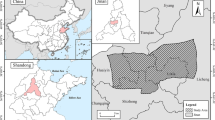Abstract
The urban structure has an important influence on the thermal environment. Exploring the relationship between urban structural elements and thermal environment is helpful to find the objective laws between them, which has great significance for rational urban layout and improvement of climate comfort. In this chapter, urban structure is divided into three categories: function, morphology, and underlying surface. The calculation methods of the seven structural indicators under these three categories are discussed in detail. Then, in order to explore the spatial differences of urban thermal environment, taking Xi’an, a metropolis in northern China as an example, 55 fixed sample points were selected, and a 3-year field measurement of the thermal environment data in summer and winter was carried out. Based on the ArcGIS system, the meteorological data and the urban characteristic data are integrated to allocate more meteorological data, and the interpolation method is applied to express the meteorological single factor spatially. Then, the correlation between the calculated seven urban spatial structure indicators and the thermal environment parameters after interpolation is analyzed separately, and the relationship between them is discussed. Finally, the urban climate recommendation map is drawn, and the urban spatial structure optimization strategy from the perspective of urban thermal environment is formulated.
Access this chapter
Tax calculation will be finalised at checkout
Purchases are for personal use only
Similar content being viewed by others
References
Oke TR (2006) Towards better scientific communication in urban climate. Theor Appl Climatol 84(1–3):179–190. https://doi.org/10.1007/s00704-005-0153-0
Xi'an Statistical Bulletin on National Economic and Social Development in 2019 (2022) Accessed 2022.6.15
Qunjie Z (2018) China statistical yearbook. China Statistics Press 2019, Beijing
China MoHaU-RDotPsRo (2014) Design standard for thermal environment of urban residential areas. Beijing: Ministry of Housing and Urban-Rural Development of the People's Republic of China
Xu D, Zhou D, Wang Y et al (2020) Temporal and spatial variations of urban climate and derivation of an urban climate map for Xi'an, China. Sustain Cities Soc 52:101850. https://doi.org/10.1016/j.scs.2019.101850
WHZYA (2015) Fangzhou (2015) research on the vegetation coverage of basic farmland crops based on Landsat-8. China Agricultural Science Bulletin 31(02):269–275
Zhifei Y (2016) The improvement of water extraction model and algorithm based on MODIS remote sensing data. Geomatics & Spatial Information Technology 39(08):117-20+24
Xiaotu L, Chen Enshui YD (1997) Improvement of urban thermal environment and its microthermal environment, vol 01. Environmental Science
Lowen AC, Mubareka S, Steel J et al (2007) Influenza virus transmission is dependent on relative humidity and temperature. PLoS Pathog 3(10):1470–1476
Thom ECJW (1959) The discomfort index. Weatherwise 12(1):57–60
General Administration of Quality Supervision IaQotPsRoC (2012) Climatic suitability evaluating on human settlement. Standardization Administration of China
Peng S (2017) Optimized study on spatial interpolation methods for meteorological element. Geospatial Information
Jinjie LI, Wang A (2019) Comparison of spatial interpolation methods based on monthly precipitation Observation data of station in Southwest China. Climatic and environmental. Research
Yi TGZMYXZ (2001) Geographic information system: principles and applications. Science Press
Wenqing HX (2015) Applied regression analysis. China Renmin University Press, Beijing
Changchun ZYYPD (2018) Analysis on suitability of livable climate in Pu'er city. Meteorological and Environmental Sciences 41(02). https://doi.org/10.16765/j.cnki.1673-7148.2018.02.006
Ng E, Ren C, Mills G et al (2015) The urban climatic map: a methodology for sustainable urban planning, p 2015
Author information
Authors and Affiliations
Corresponding author
Editor information
Editors and Affiliations
Rights and permissions
Copyright information
© 2023 The Author(s), under exclusive license to Springer Nature Singapore Pte Ltd.
About this chapter
Cite this chapter
Zhou, D., Xu, D. (2023). Urban Structure and Its Environment. In: Gao, W. (eds) Digital Analysis of Urban Structure and Its Environment Implication. Advances in 21st Century Human Settlements. Springer, Singapore. https://doi.org/10.1007/978-981-19-6641-5_9
Download citation
DOI: https://doi.org/10.1007/978-981-19-6641-5_9
Published:
Publisher Name: Springer, Singapore
Print ISBN: 978-981-19-6640-8
Online ISBN: 978-981-19-6641-5
eBook Packages: Biomedical and Life SciencesBiomedical and Life Sciences (R0)




